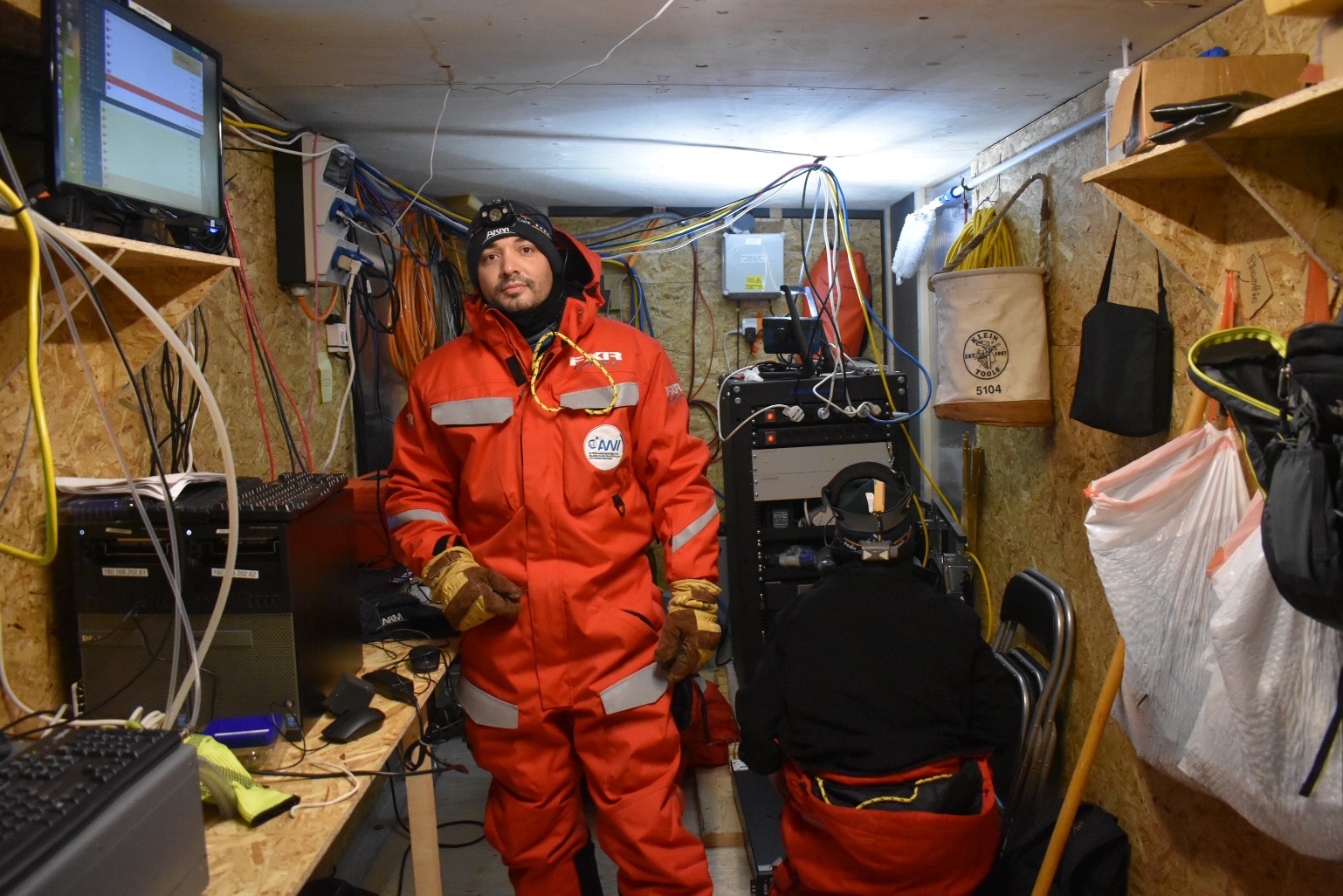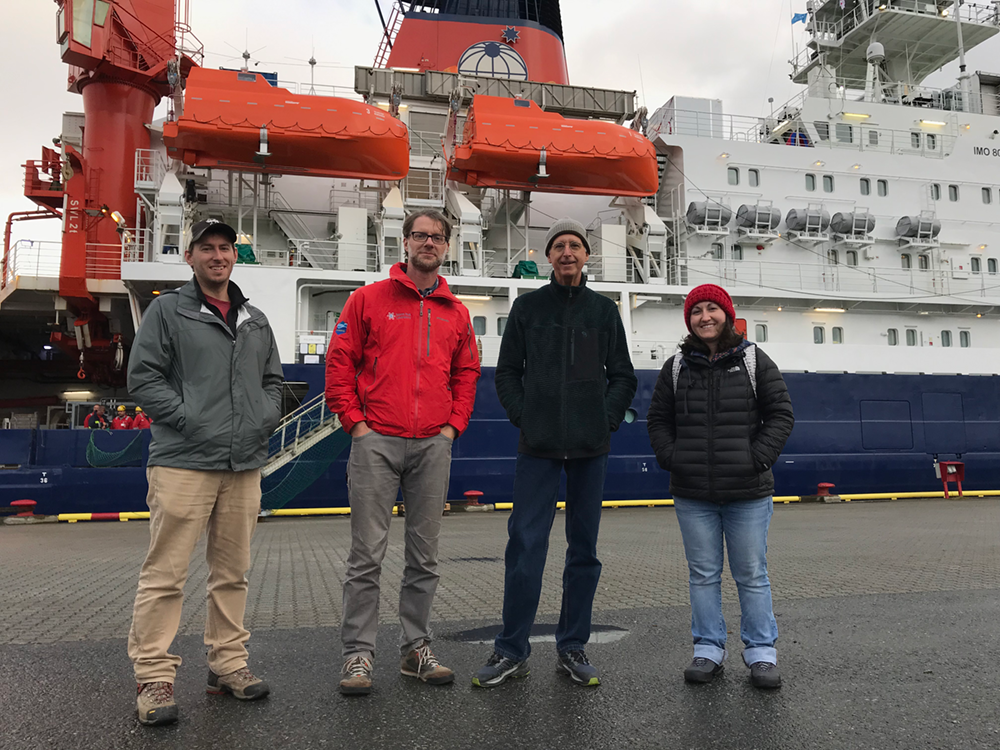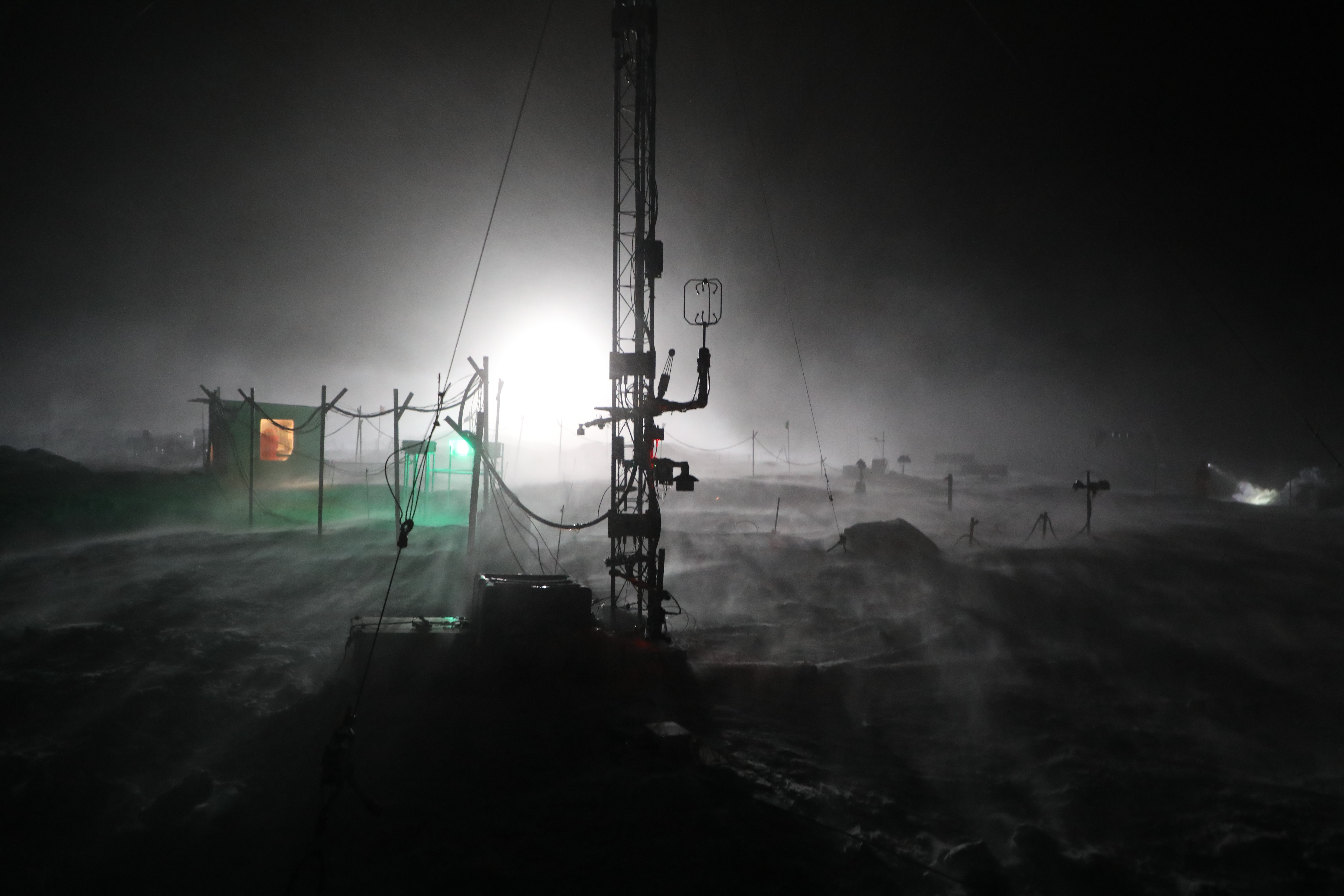MOSAiC: A Sustained Echo of Data
Published: 16 February 2021
With an epic Arctic Ocean expedition at an end, researchers wrangle with rich ARM measurements

More than once during the central Arctic winter of 2019–2020, radar technician Vagner Castro scrambled onto the frigid monkey deck of the ice-locked R/V Polarstern to replace tiny screws on the inlet door of an aerosol sampler.
Castro’s moments of effort in harsh conditions are emblematic of a full year of hard work by hundreds of scientists, engineers, and technicians who took part in history’s largest, most data-rich expedition for arctic science, 12 years in the making: the Multidisciplinary Drifting Observatory for the Study of Arctic Climate (MOSAiC).
The Arctic Ocean, about the size of the continental United States, is the largest feature of an area where climate warming is accelerating faster than anywhere else in the world. In particular, declining levels of sea ice spark scientific concern. MOSAiC allowed unusual, year-round access to this remote, inhospitable, and critical environment.
At the tip of the spear during the MOSAiC effort, and among the expedition’s earliest champions, were the U.S. Department of Energy (DOE) and its Atmospheric Radiation Measurement (ARM) user facility.
ARM deployed radars, lidars, aerosol particle counters, and other atmospheric instrumentation on the bow of the Polarstern, the expedition’s mother ship. Other ARM gear was on the ice generally within 500 meters (about a third of a mile) from the vessel.
Matthew Shupe, co-coordinator of the expedition, says that ARM’s unprecedented suite of atmospheric instruments will help scientists identify and quantify cloud, aerosol, weather, and other conditions on display during MOSAiC.
“This mission is getting great data into people’s hands and enabling groundbreaking science,” he says.
And ARM data? “The awesome thing is that it’s available now,” says Shupe. “Now is where the excitement is.” (Access the data in ARM Data Discovery.)
Data―and Impressions Too

The scientific motivations behind MOSAiC included the Arctic’s rapid sea ice decline, a scarcity of observations, amplified changes in the Arctic compared with elsewhere, links between polar conditions and the rest of the world, and the poor predictive acuity of current models.
Improved global models are the ultimate end goal of MOSAiC data, agrees expedition leader Markus Rex of the Alfred Wegener Institute (AWI) in Germany, the expedition’s organizer.
He and Shupe were both part of a MOSAiC retrospective during the virtual American Geophysical Union (AGU) Fall Meeting in December 2020.
Rex also acknowledged the emotions MOSAiC elicited.
“We brought back data,” he says, “but we also brought back our impressions,” including “how fast the sea ice is disappearing.”
Melinda Webster, a sea ice researcher at the University of Alaska, Fairbanks, also at AGU2020 examined the last 42 years of satellite imagery of arctic sea ice extent; the last 14 years show record-breaking minimums.
This vivid record of ice cover decline, she says, “places into context how rapid the changes are in the Arctic” and how important it was for MOSAiC to take place when it did.
Observe and Record

MOSAiC ceased activity in October 2020, when the Polarstern eased into a dock in Bremerhaven, Germany. The expedition’s fifth and final leg was over, but with so much data to absorb (about 150 terabytes), the work of MOSAiC had just begun.
To collect this abundance of measurements, the German research icebreaker―bristling with onboard and ice-camp instruments―anchored itself in October 2019 to an ice floe, setting off on a fruitful drift across the Arctic Ocean. MOSAiC’s mission was to observe and record the state of the central Arctic, which especially in the depths of the months-long polar night was in many ways a mystery. (Mission collaborators took in pan-Arctic data too, including from satellite platforms.)
Scientists on the Polarstern (and in thematic encampments arrayed around the ship) pulled in data on arctic atmospheric processes, sea ice dynamics, snow properties, ocean ecosystems, and more. Getting comprehensive physical data was an emphasis too, prompting researchers to transport home such samples as ice, algae, fish, microbes, and seawater.
Remote, unique, daring, and comprehensive, MOSAiC can be summed up in a mosaic of facts and impressions. Imagine, for instance, one year moored to an ice floe in the central Arctic. Scientists from 20 nations. Polar bears. Miles-long cracks in sea ice. Twenty arctic cyclones. Fantastical ice ridges. Snow as fragile as dry leaves.
An Eager Audience of Modelers

Shupe, who works for the Cooperative Institute for Research in Environmental Sciences (CIRES), was present for Legs 1 and 4 of MOSAiC. His expedition tasks included being overall co-coordinator, atmospheric team lead, and a principal investigator on multiple projects, including the ARM-generated atmospheric, cloud, precipitation, radiation, and aerosol measurements. He has funding for his MOSAiC work from DOE’s Atmospheric System Research (ASR).
The second ARM Mobile Facility (AMF2) was aboard the ship with some instrumentation close by. MOSAiC also maintained a distributed network of instruments spanning a radius of 50 kilometers (31 miles).
Shupe was also the principal investigator for a project on surface energy fluxes funded by the National Science Foundation and NOAA.
He expects that in the spring of 2021, a spate of summary papers will arrive and that in three years or less, earth system models will be sharpened by expedition measurements.
In particular, the rich and rare data gathered by MOSAiC scientists have an eager and immediate audience, says Shupe. “We have a whole community of international modelers just waiting anxiously for data to be packaged for them.”
That community of modelers includes those associated with the Year of Polar Prediction, the main activity of a 10-year (2013–2022) project led by the World Meteorological Organization. It brings together operational modeling centers around the world, each with an intensive interest in the Arctic.
Measured in terabytes, one of the largest fractions of MOSAiC data comes from ARM, says Shupe, much of that from 60-plus instruments in AMF2.
MOSAiC’s on-ice activities included a research station called Met City, in which ARM meteorological instruments played a significant role.
Arctic Heating and Cooling

Papers based on MOSAiC data will soon fall in flurries, as Shupe suggests, and studies are zipping ahead like sleet.
For one, Shupe is part of an emerging investigation of arctic clouds, which have a substantial impact on the sea ice surface energy budget. Such clouds can be optically thick, when dominated by liquid water, or optically thin, as in ice clouds or clear sky.
Shupe presented some of this work at AGU2020, during which he convened several MOSAiC-related sessions.
He and co-researchers are studying the response of surface energy budget processes to cloudy skies versus clear skies. In the coupled atmosphere-ice-ocean system, clouds drive changes in surface radiation. They also modulate surface temperatures, the turbulent exchange of heat at the surface, and the way heat conducts through sea ice.
Shupe and others are also examining how these surface energy budget processes shift as winter transitions into springtime. This onset of surface melt over sea ice has been the subject of studies by Shupe research collaborator Christopher Cox of NOAA’s Physical Sciences Laboratory in Colorado.
Their combined study examines the surface energy budget in detail so that springtime warm air intrusions and their effect on ice melt are better understood. The goal is a conceptual model of cloud impacts on sea ice in the central Arctic.
“I want to do more analysis to represent that,” says Shupe of the evolving work. “We’ve only just started digging in.”
Arctic Ice-Nucleating Particles

Little is known about arctic aerosols, tiny atmospheric particles that are the seeds of cloud-particle formation.
Jessie Creamean, an atmospheric scientist at Colorado State University, was among many aerosol researchers who rushed to take part in MOSAiC. (Funding for her work comes from ASR.)
In the bow of the Polarstern, AMF2 included an Aerosol Observing System, which measures the properties of atmospheric particles and trace gases. Creamean, a MOSAiC Leg 1 veteran who also used university instrumentation, has a special interest in ice-nucleating particles (INPs). In 2020, ARM hired her and Colorado State colleague Tom Hill to be its mentors for INP sampling and analysis.
Swept into the atmosphere, INPs trigger the freezing of supercooled cloud droplets and influence cloud reflectivity and life span. Creamean and three Colorado State co-authors presented a poster during AGU2020 that outlined their attempts during MOSAiC to evaluate INPs and their sources in the central Arctic.
Creamean and the others called arctic INPs “vastly understudied” before MOSAiC. Now scientists have a year’s worth of all-season INP data.
The big goal, she says, is to get a picture of INP abundance and sources (including biological) during a full sea ice cycle. Once they do that, the answer to an old question is closer: How do INPs modulate cloud-ice formation in the central Arctic?
Aerosol Particles and Trace Gases

Helping to set up AMF2 in the first month of MOSAiC was Janek Uin, an ARM instrument mentor at Brookhaven National Laboratory in New York.
His last day aboard the Polarstern was October 16 after a September 20 departure from the expedition’s home base at Tromsø, Norway, he noted in a blog. But he left AMF2 behind with teams of technicians that would rotate in and out for a year.
During AGU2020, Uin walked through an analysis of ARM aerosol time-series data spanning October 2019 to mid-May 2020. The entire period, he says, was marked by generally low trace gas amounts and aerosol number concentrations. Carbon monoxide remained low, without strong seasonal variations. Minor spikes created small increases in particle number concentration that correlated with helicopter or snowmobile activity near the ship.
Further data analysis will include particle chemical composition but leave out samples associated with local contamination.
Says Uin, “It’s clear the data need to be filtered.”
Estimating Snowfall

For a brief but vivid glimpse of research life out on arctic ice, you might start with a blog post by David Wagner, a PhD student at the Institute for Snow and Avalanche Research (SLF), Swiss Federal Institute for Forest, Snow, and Landscape Research (WSL) in Davos, Switzerland.
As a member of MOSAiC’s Sea Ice Team, he and a few teammates set out to get data for reliable estimates of snow on sea ice during Leg 1 of the expedition (October 24 to December 15). Such estimates are important to a lot of arctic sea ice research, in part because snowpack is important for ocean-atmosphere heat exchange.
Wagner and others leveraged the fact that snowfall rates can be derived from radar reflectivity, so they leaned on datastreams from―among other instruments―ARM’s zenith-pointing and scanning cloud radars. Wagner shared this work during AGU2020.
The Shape of Arctic Cyclones
MOSAiC afforded scientists a unique all-season, ARM-aided view of arctic cyclones. During the expedition, 20 such cyclones swept through the expedition’s observational domain.
On hand to observe some of those storms, at both MOSAiC’s beginning (Leg 1) and end (Leg 5) was veteran CIRES polar scientist Ola Persson, another AGU2020 presenter. He was one of the initiators of MOSAiC and an advocate for using an ARM Mobile Facility. During the expedition, he was part of teams linked to investigations of the atmosphere, modeling, sea ice, and remote sensing.
Researchers note that MOSAiC was a rare opportunity to observe arctic cyclones over an entire annual cycle, from freeze-up to melt and back to freeze-up.
Arctic Evolution

Warmer. Less frozen. Biologically altered.
That sums up the state of the Arctic as laid out in the latest edition of the Arctic Report Card, a book of science essays published by NOAA every year since 2006.
Shupe authored a report card essay entitled “The MOSAiC Expedition: A Year Drifting with the Arctic Sea Ice,” which he termed the best-equipped investigation of the central Arctic to date.
Another essay spelled out declines in arctic sea ice cover related to the extent, thickness, and volume. (The second-lowest summer extent on record occurred in 2020.)
Sea ice is important to the climate system. It reflects solar radiation back out into the atmosphere during the summer. Without ice cover, the Arctic gets warmer.
The decline and evolution of sea ice cover, and its consequences, says Shupe, was the largest of all MOSAiC’s motivating scientific questions.
To address this foundational concern, 20 nations took part in MOSAiC. In all, 37 nations were represented by people out on the ice; about 300 were researchers, many of them early career scientists.
In a show of “true international cooperation,” says Shupe, “we learned a lot about fieldwork in the Arctic and how to study this rapidly changing region.”
MOSAiC put scientists “in the middle of arctic change,” he adds, “to experience the urgent processes that affect the current and future state of the Arctic, and to obtain the unprecedented data set.”
That legacy of data is the expedition’s enduring gift, says Shupe, and “will feed the arctic research community for years.”
Keep up with the Atmospheric Observer
Updates on ARM news, events, and opportunities delivered to your inbox
ARM User Profile
ARM welcomes users from all institutions and nations. A free ARM user account is needed to access ARM data.


















